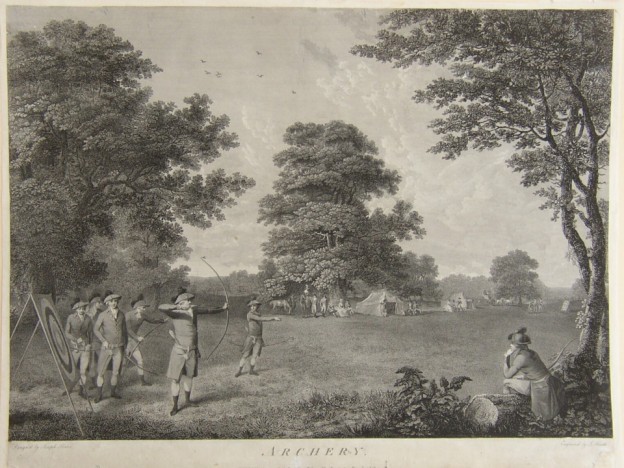While our normal club meetings are very informal, there are a number of things it would be useful for you to know before you go to your first competition. Don’t worry if some of this seems a bit overwhelming, many people just turn up to their first competition and find out what to do on the day, but a little more information can’t hurt.
[toc]
Dress Code

Archery dress code – not!
Joking aside, many competitions expect you to respect the archery dress code. That means either club colours, or the official archery colours: green and/or white. Definitely no blue denim, and no olive drab ().
Our club colours are black tops with gold trim and the club badge, and black trousers/skirts. Ladies may wear trousers, and shorts are OK if the weather is warm. Of course novices (unclassified archers in their first season) aren’t really expected to have obtained their kit yet.
Longbow Archers traditionally wear all white, though green or club colours are fine too.
If the weather is inclement, even at a formal event the dress code can be waived so that people can put on waterproof clothing etc.
Having said all that, friendly competitions aren’t usually so strict, but if you have club kit or greens or whites it’s nice to make an effort.
More Lines than Usual
At a minimum, as with our club meetings, there will be a shooting line and a waiting line. In a big competition there may also be:
- Three metres in front of the Shooting Line a line for dropped arrows. Any arrow falling between the shooting line and this line may be deemed as not shot (at the judge’s discretion) and another arrow shot in its place.
- Behind the Waiting Line there can be an Equipment line. Bows should be placed behind this line when not in use.
- Behind the Equipment Line a Tent Line, Tents should be pitched behind this line.
- Behind the Tent Line, if you’re lucky, a Catering Line for hot dogs and ice cream.
In practice not all of these lines will be present, the normal three are the Shooting Line, the Waiting Line and the Tent Line.
Membership Cards
Remember to bring your Archery GB membership card with you. If you don’t have one yet you’ll need to get a covering note from our club treasurer (Deborah) or secretary (Helen) to confirm you are a member.
Bring a Chair and a Tent
If you have them. Competitions are often all day events and that’s a long time to be on your feet. Plus rain will not stop a competition, and there’s not always a lot of shelter, so a tent is a really good idea. A folding camping chair is the most practical chair, and the best sort of tent is a one man fishing “bivvy” or like this:

(Ignore the fisherman.) It is tall enough to put the chair in and sit upright, but they are quite difficult to get hold of. Our club has a fairly large gazebo-style tent that we try to take with us whenever enough of us are attending a competition, but it’s a good idea to have your own tent just in case.
Bring a Packed Lunch
Many competitions are held in very rural settings, there may be no local shops and there is no guarantee that the hosts will provide any catering, so come prepared.
Get There Early
On the entry form you’ll see a time for assembly (welcoming everyone, introducing the organisers and the Judge, and explaining the rules) and usually 15 minutes after assembly a time for sighters, which is when the competition actually starts. You should give yourself plenty of time to sign in, pitch a tent and set up your equipment before the assembly. Half an hour is cutting it fine, especially if you’ve never been to that venue before; an hour is good, so you don’t feel rushed.
Sign In
When you first arrive at a competition, you should seek out the hosts and sign in (you don’t actually have to sign anything, just let them know you’re there). They will normally have a gazebo with someone manning a desk. If you don’t know your target allocation they will tell you.
Target Allocation
The organisers of the competition will have drawn up a “target listing” beforehand, and you should receive a copy a couple of days before the event. Targets are numbered 1, 2, 3, 4, 5 etc. For an outdoor round there will be four places on each target labelled A, B, C and D. You will be allocated a target and a placing, i.e. “4A”. The target numbers will be attached to the target stands and positions along the shooting line directly in front of each target will be similarly numbered. Position C is called the Target Captain, and is responsible for scoring. In serious competitions position D is the Target Lieutenant who assists the Target Captain in resolving disputes, although the Judge is the final arbiter.
Shooting Order
This is a bit complicated but you’ll get used to it.
The four archers on a target are divided into two pairs, or details: A & B, and C & D.
For odd numbered ends (first, third, fifth etc.), when the first whistle blows the first detail of archers, A & B, go to the shooting line, standing either side of their target number, and shoot three arrows. Then they return to the waiting line while the second detail C & D go to the shooting line and also shoot three arrows. This then repeats. When everyone has shot six arrows and everyone is back behind the waiting line, the second whistle blows to score and collect.
For even numbered ends (second, fourth sixth etc.), it’s the same except that the second detail of archers shoot first.
It’s easy to remember if you look at your scorecards. If you’re in the first detail, you’ll shoot first for the left hand half dozen of each dozen. If you’re in the second detail you’ll shoot first for the right hand half dozen of each dozen.
The main reason for all this is to keep everything as fair as possible, giving everyone an equal chance to shoot first at an empty target. Plus, over a long competition, shooting three and three is much less tiring than six at a time. The other good reason for doing it is that there is often not enough room to squeeze everyone on the shooting line at once, and even if you could, those nearest the middle on each target have a slight but unfair advantage. In fact we may start doing this at our normal club meetings as our membership grows; it’s actually a much more pleasant way to shoot once you get the hang of it.
Scoring
Remember when you are scoring that you shouldn’t touch your arrows. You can and should point at your nocks when calling out your score, but if you touch them you could be accused of wobbling them to make them cut a line so it’s not allowed. In a serious competition you may forfeit any arrow you touch, so don’t touch them.
Bouncers and Hangers
If your arrow bounces out of the target, and other archers have seen it and confirm this to the judge, you may shoot a spare arrow in its place.
If your arrow hits the target but does not penetrate, so that it is hanging down from the target and potentially obstructing other arrows from hitting, you should alert the judge who will call a Fast and push your arrow in to the target.
Alerting the Judge
The proper way to alert the judge for whatever reason is to hold your bow above your head while on the shooting line. Be aware that other archers are still shooting and you should not disturb them unduly.
No Smoking on the Range
If you need to smoke, you should walk to the back of the range, behind the tents or whatever the rearmost line is, or just step out of the range to the side.
No Smartphone Apps
At least not at the target face. This is obviously quite a recent rule but it has been decided that smartphone apps slow down scoring, and competitions have to run to a tight schedule if they are to finish on time.
Equipment Failure
If you have a problem with your equipment, such as a broken string, and you can fix it within five minutes, you should stand at the shooting line (assuming that is where it happened) and hold your bow up in the air to attract the attention of the judge.
Shooting Line Etiquette
There are a few things that are considered polite and good form at a competition, friendly or otherwise. In fact it’s a good idea to practice these simple guidelines at our club shoots too.
No talking on the shooting line
Some people find it distracting. Of course you can chat away all you like behind the waiting line, as long as you’re mindful of the archers who are still shooting and you are not being too loud. Remember that Archery is a sport that takes enormous concentration to do well, and in a serious competition even the slightest distraction can be costly.
Don’t move if anyone near you is at full draw
When you are about to step up to or leave the shooting line, look to see if there are any archers either side of you that are at full draw. If they are, it is considered polite to remain as still as possible until they have either shot that arrow or let down, to avoid distracting them.
Don’t leave anyone alone on the shooting line
This is a nice little rule. If you finish shooting and there is only one other person anywhere on the line still shooting, even if they are not at full draw it is still polite to wait at the line with them until they have finished, as a sort of moral support so they don’t feel pressurised into rushing their last shots.
A Good Archer
This description of “A Good Archer” comes from the ArcheryGB “Rules of Shooting” document. A good archer:
- Does not talk in a loud voice whilst others are shooting.
- Does not talk to another competitor who obviously prefers to be silent.
- Does not make any exclamation on the shooting line that might disconcert a neighbour in the act of shooting.
- Does not go behind the target to retrieve his arrows before his score has been recorded.
- Does not walk up and down the shooting line comparing scores.
- Does not touch anyone else’s equipment without permission.
- Does not leave litter.
- When calling scores does so in groups of three, for example ‘7 – 7 – 5’ pause ‘5 – 5 – 3’.
- If he breaks another’s arrow through his own carelessness, pays for it in cash on the spot.
- Thanks the Target Captain at the end of each round for work on his behalf.


